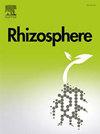莱州湾3种滨海盐生植物根际土壤真菌多样性及群落结构分析
IF 3.4
3区 生物学
Q1 PLANT SCIENCES
引用次数: 0
摘要
盐生植物在其根周围具有独特的微生物多样性和群落,在逆境适应中起着重要的生态作用。然而,目前对莱州湾沿海盐生植物根际土壤真菌的认识有限。因此,本研究旨在利用Illumina测序技术,探讨盐生植物(Suaeda glauca, SG)、芦苇(phagmites australis, PA)、绿尾草(Setaria viridis, SV)和块状土壤(CK)根际土壤中真菌的多样性、组成、共生网络和真菌功能。在所有样本中共发现1,867,704个reads和2024个扩增子测序变体(amplicon sequencing variants, asv)。结果表明,盐生根际土壤真菌群落的丰富度高于普通土壤,且SV组的α多样性高于SG组。β多样性分析显示,除PA组和SV组之间存在显著交叉外,其余各组之间存在明显的分离。在所有组中发现了更独特的asv, PA和SV组共享的asv数量约为PA&;SG或SV&;SG组的3倍。子囊菌是所有样品中最占优势的门。此外,PA组和SG组的子囊菌群丰度以及SV组的罗泽洛菌群丰度均高于CK组(p <;0.05)。单孢子菌是CK组的优势真菌属,在盐生植物根际土壤中呈下降趋势。Talaromyces、Zopfiella、exserhilum和Neocamarosporium等属在盐生根际土壤中的丰度高于块状土壤,不同类群间丰度不同的属因盐生植物种类而异。此外,与散装土壤相比,盐生根际土壤具有更高的网络大小、模块化和相似的真菌共发生网络复杂性。结果表明,盐生植物根际真菌的病原菌丰度明显降低,但腐殖质功能群落的丰度高于散装土。该研究有助于了解盐碱土壤中盐生植物与其根际微生物群之间的相互作用,为盐碱环境下提高作物抗逆性和生产力提供潜在的微生物策略。本文章由计算机程序翻译,如有差异,请以英文原文为准。
Analysis of fungal diversity and community structure in rhizosphere soil of three coastal halophytes at Laizhou bay, China
Halophytes harbor distinct microbial diversity and communities around their roots, which play a crucial ecological role on stress adaptation. However, there is limited knowledge about the fungi in rhizosphere soil of coastal halophytes at Laizhou bay in China. Thus, we aimed to explore the fungal diversity, composition, co-occurrence network and fungal functions in the rhizosphere soil of halophytes including Suaeda glauca (S. glauca, SG), Phragmites australis (P. australis, PA), Setaria viridis (S. viridis, SV) and bulk soil (CK), by utilizing Illumina sequencing techniques. A total of 1,867,704 reads and 2024 amplicon sequencing variants (ASVs) were found in all samples. We showed higher richness in fungal communities of halophyte rhizosphere soil (P. australis and S. viridis) than bulk soil, and SV group had more alpha diversity relative to SG group. The analysis of beta diversity showed clear separation across all groups except significant crossover between PA and SV groups. The more unique ASVs were found among all groups, PA and SV shared about three times number of ASVs than PA&SG or SV&SG group. Ascomycota was the most dominant phylum in all samples. In addition, the abundance of Ascomycota in the PA and SG groups, and Rozellomycota in the SV group, were higher than that in the CK group (p < 0.05). Interestingly, Monosporascus as fungal pathogen was the predominant fungal genus in the CK group, but decreased in rhizosphere soil of halophytes. Some genera including Talaromyces, Zopfiella, Exserohilum and Neocamarosporium had higher abundance in halophyte rhizosphere soil than that in bulk soil, and the genera with different abundance among groups depend on halophyte species. In addition, the halophyte rhizosphere soil had higher network size, modularity and similar fungal co-occurring network complexity comparing with bulk soil. Lastly, the fungal functionality showed decreased abundance of fungal pathogen, but higher saprotrophic functional guilds in halophyte rhizosphere than that in bulk soil. The study may contribute to understanding of the interactions between halophytic plants and their rhizosphere microbiota in saline-alkali soils, which may provide insights into potential microbial-based strategies for improving crop resilience and productivity in saline environments.
求助全文
通过发布文献求助,成功后即可免费获取论文全文。
去求助
来源期刊

Rhizosphere
Agricultural and Biological Sciences-Agronomy and Crop Science
CiteScore
5.70
自引率
8.10%
发文量
155
审稿时长
29 days
期刊介绍:
Rhizosphere aims to advance the frontier of our understanding of plant-soil interactions. Rhizosphere is a multidisciplinary journal that publishes research on the interactions between plant roots, soil organisms, nutrients, and water. Except carbon fixation by photosynthesis, plants obtain all other elements primarily from soil through roots.
We are beginning to understand how communications at the rhizosphere, with soil organisms and other plant species, affect root exudates and nutrient uptake. This rapidly evolving subject utilizes molecular biology and genomic tools, food web or community structure manipulations, high performance liquid chromatography, isotopic analysis, diverse spectroscopic analytics, tomography and other microscopy, complex statistical and modeling tools.
 求助内容:
求助内容: 应助结果提醒方式:
应助结果提醒方式:


